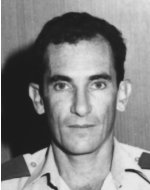Son of Rachel and Eliezer. He was born on December 12, 1942, in Tel Aviv. Who studied at the Tel Nordau Elementary School in Tel Aviv and at the Municipal High School in the Physical-Physical Track. At the beginning of August 1960, Asher was drafted into the Israel Defense Forces and completed his course in July 1962. He served in the Israel Air Force from the day he was recruited to his death, During the Six-Day War, he was shot down by many enemy planes and led by “Haapala” and combat tactics, and in 1969 he was appointed Commander of the 119th Squadron, in 1971 he was appointed commander of squadrons In October 1973 he was appointed commander of the 119th Squadron and in 1975 he was appointed Head of Branch And he was an officer in the Air Force Command and a project officer for the Kfir aircraft, who wrote: “He fulfills his role energetically, in adulthood and at the level, talented and sharp, decisive and confident.” At the time of the Yom Kippur War, Asher held a position in the air force headquarters, As a pilot in a combat squadron, and for his performance in this war he was assessed in the opinion of his commanders with excellent grades and his commander wrote: “Fight optimally with thought, courage and devotion.” He excelled as a fighter pilot and shot down many enemy planes during the Six Day War, Yom Kippur and the War of Attrition. In the various opinions that were written about the many years he served in the air force as a pilot and commander, he wrote: “A very talented officer, intellectual ability, ability to think and express, a very high level of command, sensitivity to justice, fairness and morality.” Who insisted on his resolve even when he was alone in front of other commanders. One of his commanders noted that Asher was “fighting for his views and liable to attack mines in public relations.” Despite his stubbornness when he was sure of his righteousness, he was always willing to admit when he had made a mistake. In 1977, Asher, at his request, received command of the flight school and was promoted to the rank of colonel. He spent a lot of time educating the next generation of pilots and instilling in them the love of man and understanding of the pilot. From time to time he used to read to the flight attendants what he had written about his flights and his experience in the air force. Upon completion of his duties at the flight school, his commander wrote: “He has performed his duties at a high level, promoted and developed new fields, with a view to the 80’s. In March 1979, Asher was first diagnosed with malignant melanoma. He was operated on, and everyone believed that the disease had been completely eradicated. Who went to the United States to study for a master’s degree in economics and administration at UCLA in Los Angeles. He was accepted into this prestigious university without having a bachelor’s degree from any university, thanks to the high grades he received both in the exams and in the history studies he taught at Tel Aviv University during his one-year studies in the evening and the recommendations of his commanders and teachers. At the recommendation of his commander to go to study in the United States, he wrote: “Any investment in the field of personal development will bear fruit and contribute to the Air Force and the positions it will fulfill in the future.” He completed his MA studies with very high grades. During his studies in the United States, he underwent periodic examinations with an expert physician in San Francisco, but the tests found nothing. On his return to Israel in the summer of 1981, Asher was appointed commander of the Hatzerim Air Force base and was promoted to brigadier general. In this position he also served in the Peace for Galilee War. In 1983, Asher was appointed head of the air force at the Air Force headquarters and in August1984 Received the appointment of the Air Force Chief of Staff. In 1984, more than five and a half years later, the disease returned and was again operated. The doctors believed that the operation would finally cure the disease, but it was not. When another tumor was discovered in the abdomen, it was clear that cancer had returned. For two years, Asher fought the disease and all the time he served in his position as head of the Air Force headquarters. Who fought for his life with all his strength for two and a half years. The doctors did everything in their power to ease his heavy suffering, but they could not. On Rosh Hashana, on the 5th of Tishrei 5747 (October 5, 1986), the battle for his life was decided upon, and he was brought to rest in the military cemetery in Kiryat Shaul, followed by Raya Chava, two sons – Yoram and Nimrod, parents and sister Shlomit. In a condolence letter sent by the Air Force commander to the family, he wrote: “During the year we all accompanied what we had in the struggle, we saw you struggling with him and trying to make sure that his last part of life was with substance and content in a warm and supportive family atmosphere. We were deeply impressed and greatly appreciated the way he read challenging his illness, his strong spirit and his high morale, which he tried to keep even during the most difficult times. We lost a friend to Derech Haim and to the army. We lost an excellent officer, one of the pillars of the air force and its most talented and daring fighters. “
